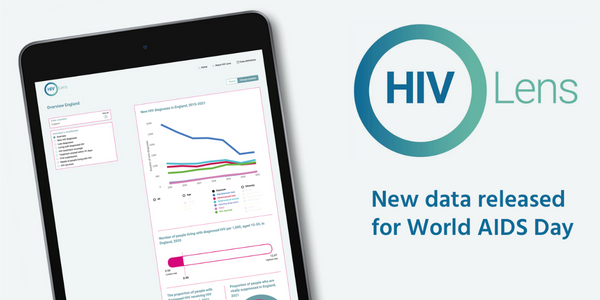What caused HIV infections to fall in the UK?

HIV infections and diagnoses have fallen dramatically among gay and bisexual men in the UK – and in several other countries – in recent years. Between 2014 and 2022, new diagnoses fell almost threefold, from 3222 to 1166 diagnoses each year.
There’s sometimes disagreement over how this can be explained and what has made the biggest difference. Is this all thanks to the introduction of the preventive medicine PrEP? Or is it due to more people receiving HIV treatment, and the fact that undetectable equals untransmittable (U=U)?
Researchers at University College London have looked carefully at the HIV epidemic in gay and bisexual men in the UK. They used a computer model to try to estimate what could have happened in different situations over the past decade. They looked at imaginary scenarios in which PrEP was not introduced, access to HIV treatment was not expanded and far fewer men used condoms.
In each situation they give the number of new HIV infections they estimate would have occurred in the UK. Note that this is different to the number of new HIV diagnoses in a year – many people are diagnosed several years late and other infections happen overseas but are diagnosed in the UK.
The model estimated that there were actually 597 new HIV infections among gay and bisexual men in the UK in 2022.
The researchers looked first at a scenario in which PrEP did not start to be used in 2015. The model predicted 1228 infections in 2022 – more than double the actual number.
The second scenario was in two first parts. Firstly, the annual number of HIV tests remained at the level it was in 2012 rather than more than doubling. Secondly, people only started HIV treatment when their CD4 count fell below 350, instead of all people with HIV being offered treatment from 2015 onwards.
In this scenario, fewer people would be on treatment and have undetectable viral loads. As a result, there would be 1237 HIV infections.
The third scenario involved levels of condom use being drastically cut. The assumption was that from 2012 onwards, rates of condom use were as low as they had been in 1980, before the first cases of AIDS and the invention of safer sex. The model predicted that the number of infections would dramatically increase for several years, until being slowed by the use of PrEP and more HIV treatment. By 2022, the annual number of infections would be 1299.
What’s striking is that in each of these three scenarios, the number of infections was roughly similar. If just one of the three methods had not been used as it was, there would have been more than twice as many HIV infections last year as there really were. Instead of around 600 infections, there would be 1200 or 1300.
In other words, the contributions of each method were remarkably similar. It’s not a question of whether it’s PrEP or U=U or condoms that has made the difference – they have all been important and had a greater impact because they have been used alongside each other.
The researchers also tried to predict how things will evolve over the next few years, assuming that PrEP, HIV treatment and condoms continue to be used as they are now. In 2025, they predict approximately 400 infections, and in 2043, around 100. Although there is a government and United Nations target of fewer than 50 infections per year by 2030, there is “zero chance” of meeting this goal according to the computer model.
HIV Lens

HIV Lens is an interactive online mapping tool that visualises the impact of the HIV epidemic on communities across England.
The latest HIV data for England have been published on HIV Lens for World AIDS Day. You can view data such as new HIV diagnoses first made in England, HIV treatment coverage and viral suppression for the whole of England as well as by region and local authority.
New guidelines on preventing heart disease

At this summer’s International AIDS Society Conference on HIV Science (IAS 2023), the single study which is most likely to affect the treatment and care of people living with HIV was about statins.
These medications are commonly prescribed to lower levels of cholesterol (fat in the blood). They are also known to lower inflammation (which contributes to the increased risk of health problems in people with HIV). By reducing both cholesterol and inflammation, they reduce the risk of cardiovascular disease and outcomes such as heart attack and strokes.
The large, international study that was presented at the conference enrolled people over the age of 40. They were all assessed to have low to moderate risk of cardiovascular disease, so they are a group who would not normally be prescribed statins. Most were stable on HIV treatment with an undetectable viral load.
The study found that those who were prescribed statins had 35% fewer ‘major cardiovascular events’ (heart attacks, strokes, angina, peripheral artery disease, heart surgery etc.) than those who did not get the statins. (You can read more about the study here.)
Now the British HIV Association (BHIVA) has issued guidelines recommending that the findings from this study be implemented in the UK. The guidance is the first in the world to do so.
BHIVA recommends that people with HIV aged 40 and over should be offered a statin. This applies to everyone in the age group, although people with higher levels of cholesterol or higher estimated cardiovascular risk might be prioritised for statin treatment.
If people are already taking a low-intensity statin (for example, pravastatin at a dose of 10mg-20mg), they should try switching to a moderate-intensity statin.
Statins will usually be prescribed by general practitioners (GPs), not at HIV clinics. BHIVA makes suggestions to HIV clinics on how they can explain this new guidance to GPs. Although the recommended statins (pitavastatin and atorvastatin) have a low risk of drug interactions with HIV treatment, the document gives doctors guidance on how they can avoid interactions.
The guidelines also say that doctors should also provide advice and signposting on smoking cessation, exercise, diet, weight management and alcohol use. Both lifestyle changes and statins are important in reducing the risk of heart disease and strokes.
aidsmapLIVE: World AIDS Day special

If you missed our aidsmapLIVE World AIDS Day special earlier this week, you can catch up on Facebook and Twitter/X.
This aidsmapLIVE special focused on inequalities, and joining aidsmap's Susan Cole were: Florence Anam from the Global Network of People Living with HIV; Dr Rageshri Dhairyawan from Barts Health NHS Trust; Bruce Richman from the Prevention Access Campaign; Idris Mwendwa from Hapa Kenya; and Erika Castellanos from Global Action for Trans Equality.
New weight-loss drugs

Many people living with HIV have seen their weight increase after starting HIV treatment, or switching to a different treatment. Recently there’s also been a lot of press coverage and scientific interest in some new drugs which help people lose weight, particularly semaglutide, better known under the brand name Wegovy. But do these drugs work in people with HIV? There isn’t much research yet, but our recent article summed up what we know so far.
One study included 225 people living with HIV, over half of whom also had diabetes. Most were doing well on their HIV treatment, but all were classified as overweight or obese. They were prescribed semaglutide or a similar drug such as dulaglutide (Trulicity). People lost an average of 5.4kg and nearly a quarter lost more than 5% of their body weight.
A second study enrolled 108 people living with HIV who did not also have diabetes. Again, they were doing well on their HIV treatment and were classified as overweight or obese. They were randomly assigned to either receive semaglutide injections or dummy injections once a week for 32 weeks. Body weight fell by 8.3% in the semaglutide group while rising by 0.2% in the dummy injections group. Almost two-thirds of those on semaglutide lost more than 5% of their body weight.
This study also included detailed analysis of where fat was located in the body, rather than just total body weight. This matters because visceral fat within the abdomen is more strongly linked with health problems than subcutaneous fat under the skin. Visceral fat fell by 13% in the semaglutide group while rising by 1.5% in those receiving the dummy injections. However, fat accumulation in the liver and around the heart did not change much in either group.
Semaglutide is generally safe, but it can cause side effects including nausea, vomiting, diarrhoea, constipation and abdominal pain. It can lead to loss of lean muscle mass as well as fat, which may be a concern for older people. So far it doesn’t seem that side effects are much different in people living with HIV, but longer-term studies involving more people with HIV are needed.
Have your say: conference bulletins survey 2023

Each year, our writers attend the world’s leading HIV conferences to report on the latest scientific research and debates. We would love to know what you think about our conference reporting. Your feedback will help us demonstrate the impact of our global conference coverage and help us plan future activities.
Please take a couple of minutes to complete our anonymous survey.
Editors' picks from other sources
UK: Politicians must act now to protect people's health data | The House
At the National AIDS Trust, we strongly believe that everybody should have the right to control how their health data is shared, so that people can have confidence that information that is highly personal to them is never shared when it shouldn’t be.
BHIVA statement on information sharing for HIV and sexually transmitted infection services | British HIV Association
BHIVA would like to clarify our position highlighting the benefits of data sharing whilst acknowledging the rights of people living with HIV to protect their status.
Irish HIV documentary 'How to Tell a Secret' is coming to Netflix | Gay Community News
Directed by IFTA award-winner Anna Rodgers and artist Shaun Dunne, the film uses genre-blurring storytelling techniques to expose the social stigma around what it is like to live with HIV today.
In-depth: how do long-acting HIV treatments work? | Spotlight
Researchers have been trying to develop antiretroviral medicines that can last for weeks, months or even years per dose. Elri Voigt explores the science behind what makes a formulation long-acting and takes a look at some particularly exciting prospects.
